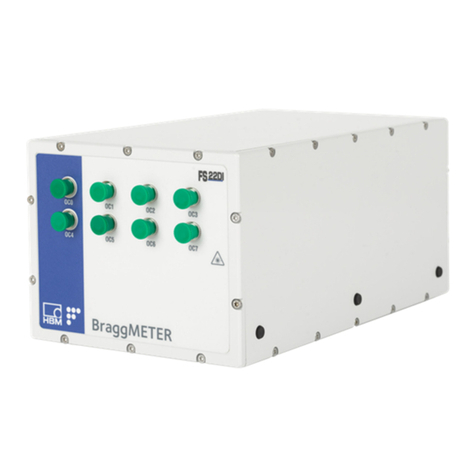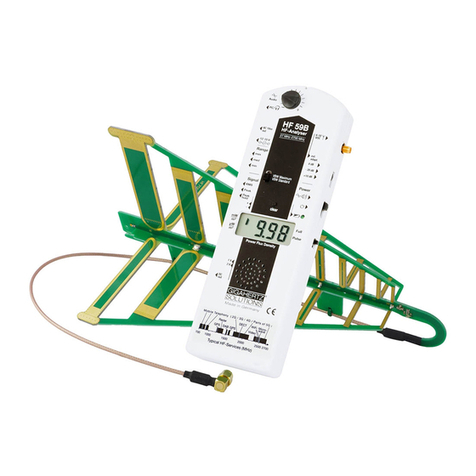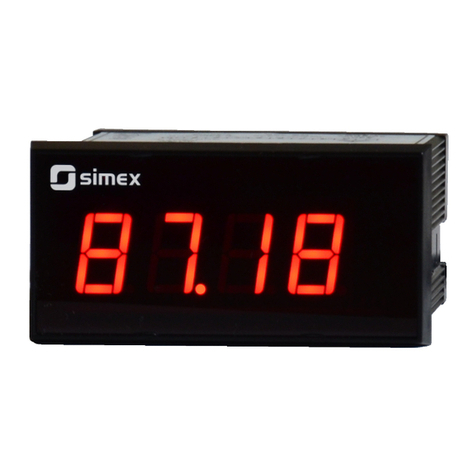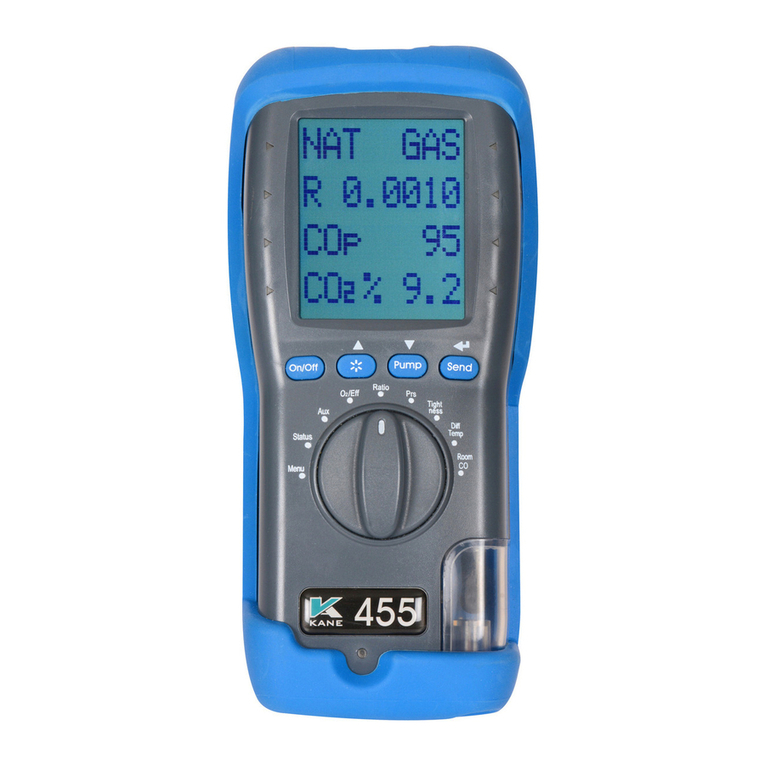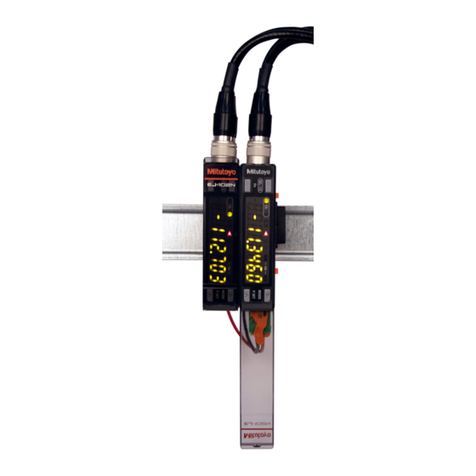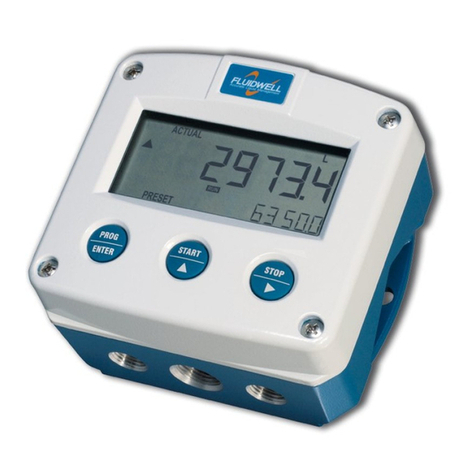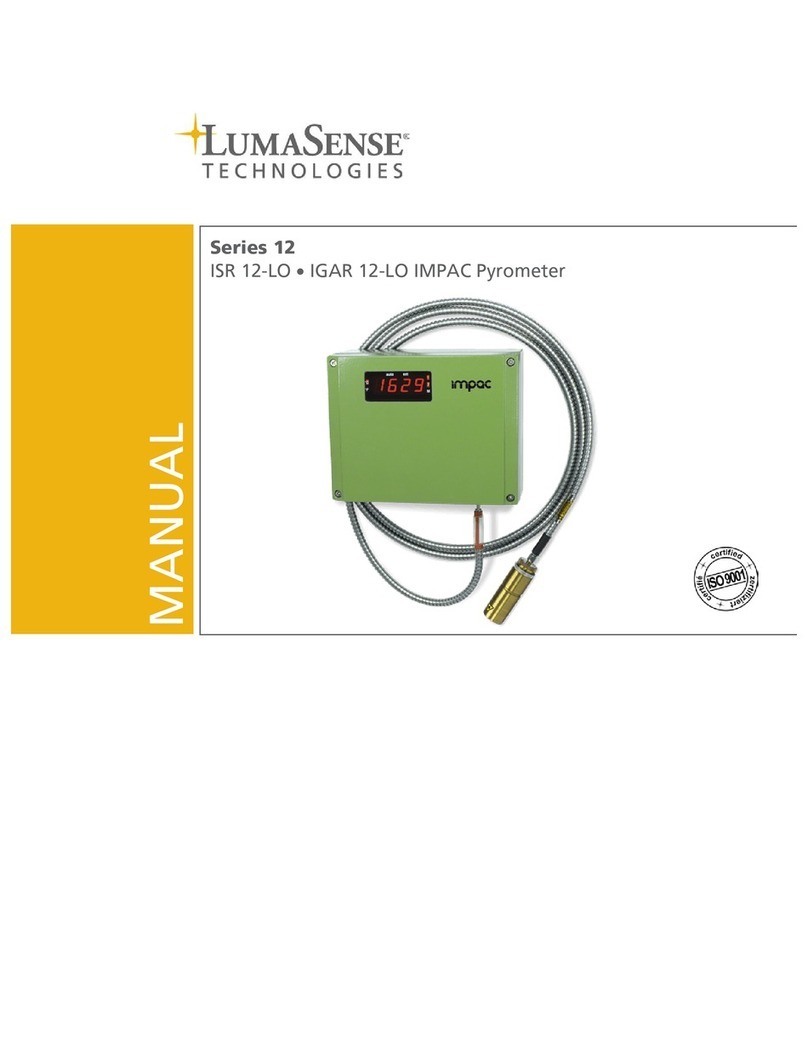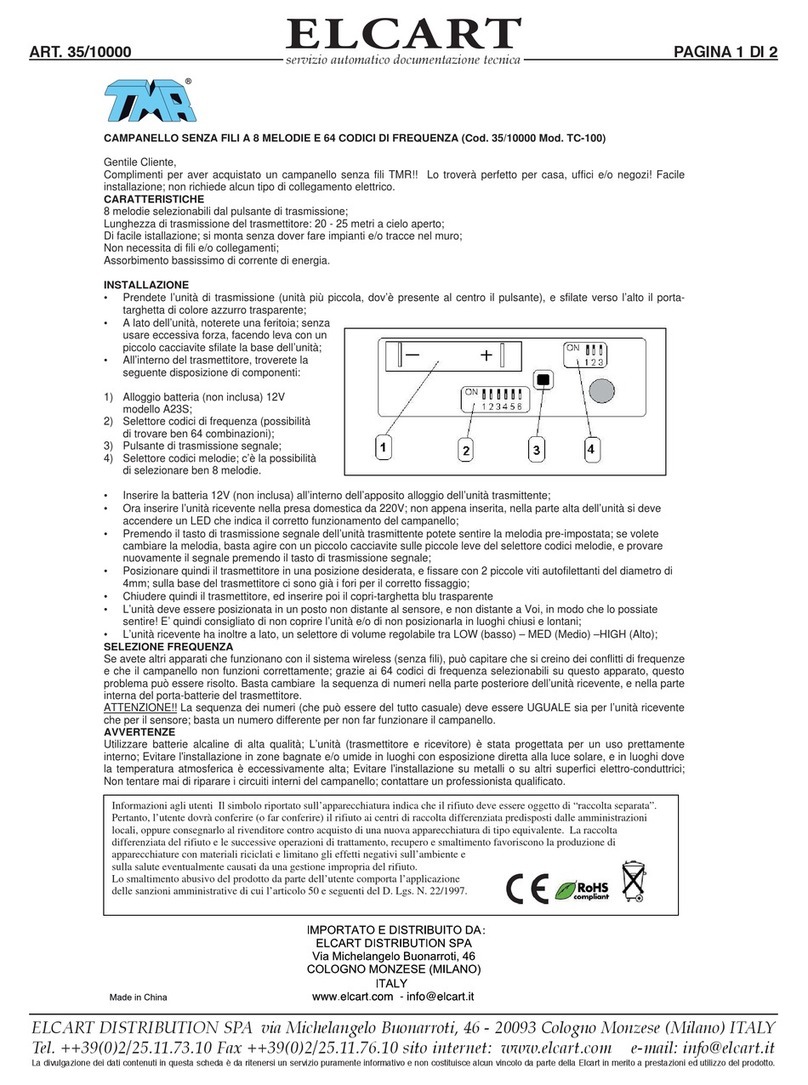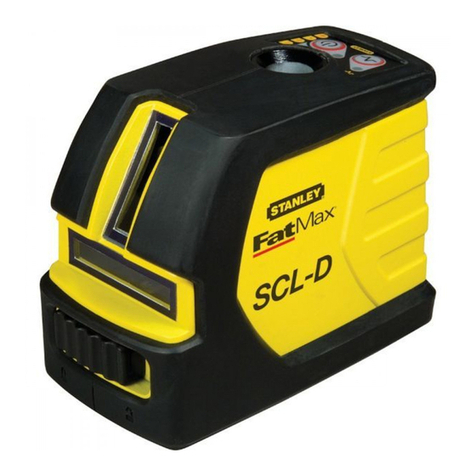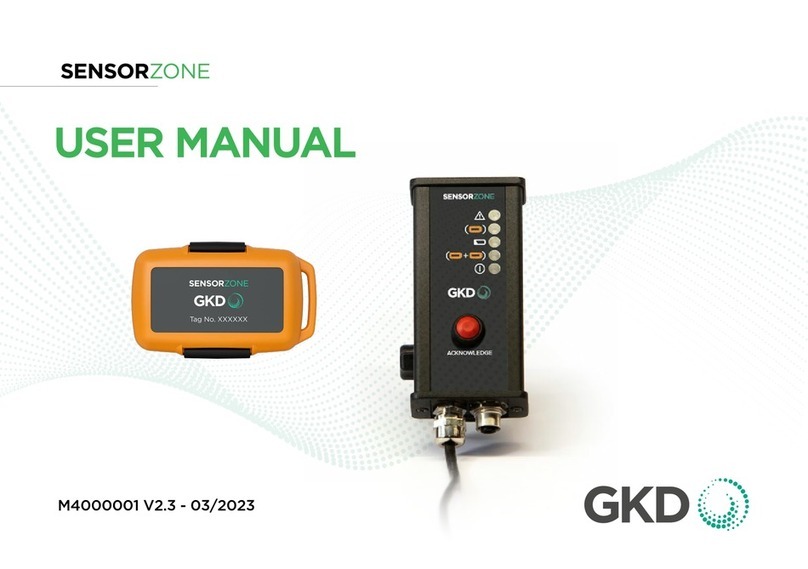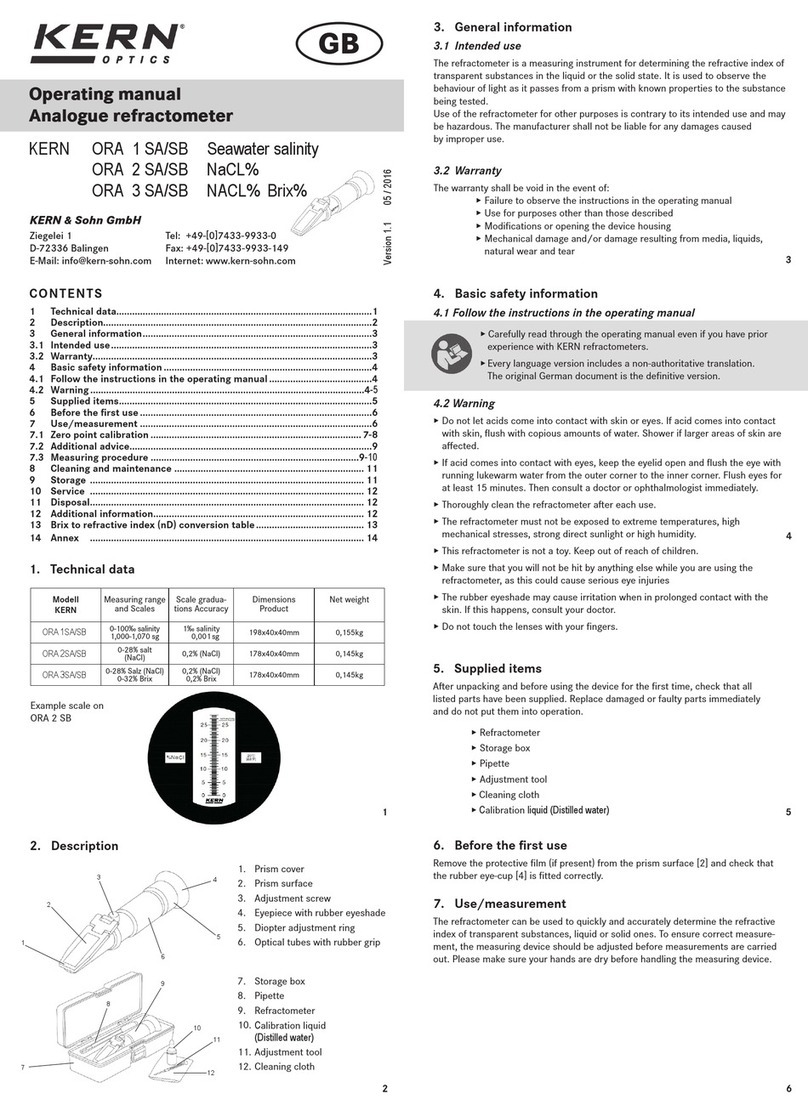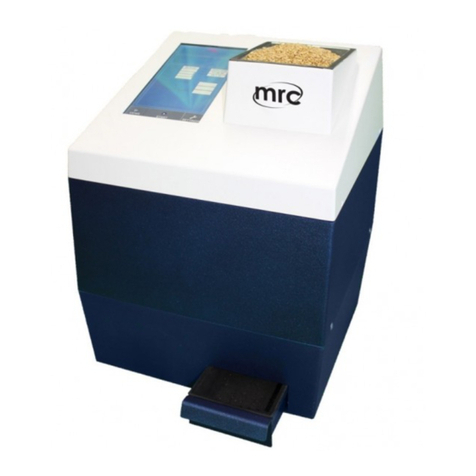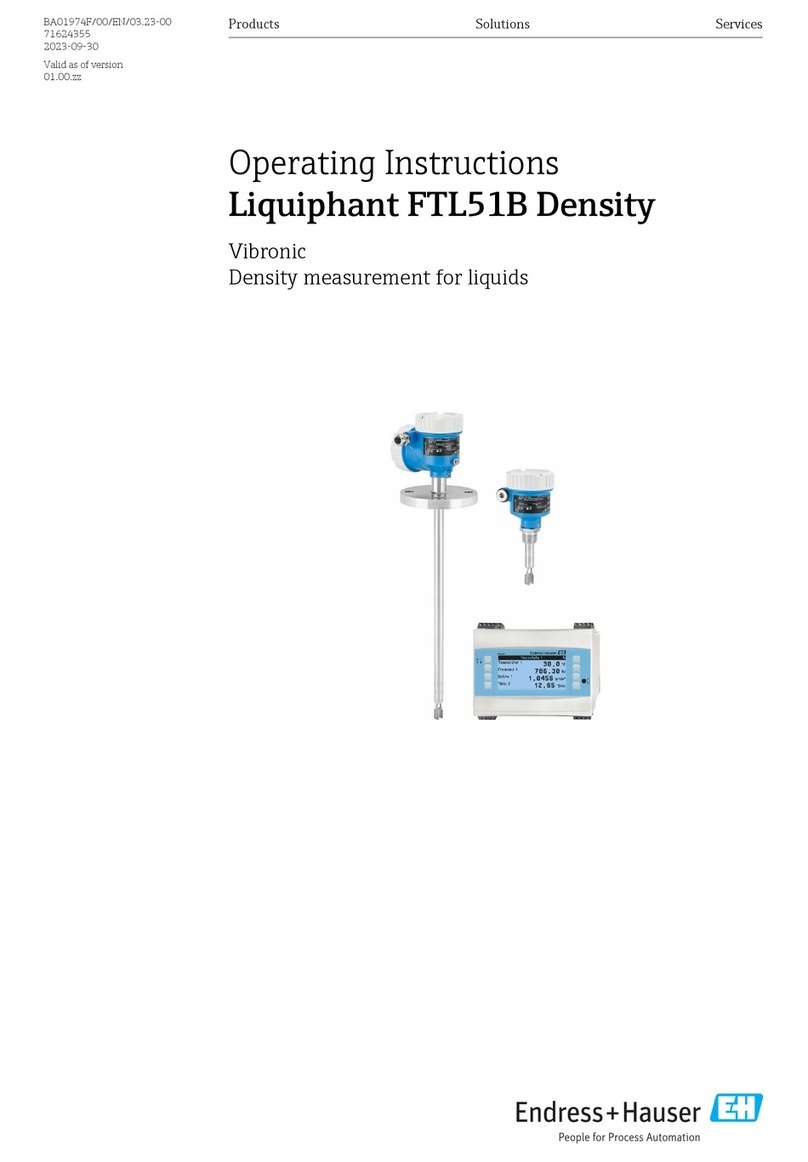ENCARDIO RITE EAN-95MW User manual

USERS MANUAL
MINING
BRIDGES
METRO & RAIL
STRUCTURAL
CONSTRUCTION
HYDROELECTRIC
TUNNELS
Doc. # WI 6002.116 Rev. 03 | July 2023
Encardio-Rite Electronics Pvt. Ltd. A-7,Industrial Estate, Talkatora Road, Lucknow, UP-226011, India | geotech@encardio.com | www.encardio.com
Encardio-Rite Group -
India | Bhutan | Bahrain | Qatar | Saudi Arabia | UAE | Peru | Greece | Spain | UK | USA
WIRELESS TILT METER
Model EAN-95MW

www.encardio.com
1INTRODUCTION 1
1.1 Wireless tilt meter overview 1
1.2 Tilt meter applications 1
1.3 Wireless network 1
1.4 Conventions used in this manual 2
1.5 How to use this manual 2
2GENERAL DESCRIPTION 3
2.1 Model EAN-95MW wireless tilt meter 3
2.2 Model EWG-01 gateway 3
2.3 System components 3
3TECHNICAL SPECIFICATION 4
4PRE-INSTALLATION PREPARATIONS 5
4.1 Pre-installation checks 5
4.2 Selecting location for Gateway and Tilt meter 5
4.3 Setting up the Gateway & Tilt meter 5
4.4 Sampling Interval for Tilt meter node 5
5QUICK START GUIDE 6
5.1 Gateway Setup 6
5.2 Tilt meter Node Setup 7
6CONFIGURING TILT METER 8
6.1 Setting up Tilt meter 8
6.2 Connecting tilt meter to phone 9
6.2.1 Connection using Bluetooth 9
6.2.2 Connection using OTG 10
6.3 Config Node 11
6.4 System Setup 12
6.5 Sensor Reading 13
6.6 Download Data 13
6.6.1 File format 13
6.7 View Data 14
6.8 Upload File 15
6.9 Node Diagnostic 15
6.10 Factory Default 16
6.11 System Information 17
7RE-CONFIGURING GATEWAY & NODES AFTER INSTALLATION 18
7.1 Re-configuring gateway via node 18

www.encardio.com
7.2 Re-configuring nodes via gateway 19
7.3 Re-configuration other nodes in same network via node 20
8REGISTER NODE AT GATEWAY 23
9INSTALLATION PROCEDURE 24
9.1 Tilt meter installation 24
9.2 Protection of tilt meter 24
9.3 Sign convention 25
9.3.1 Vertical plane 25
9.3.2 Horizontal plane 25
9.4 Environmental factors 25
10 TROUBLESHOOTING 26
10.1 Unable to connect Node over Bluetooth 26
10.2 Unable to connect Node with FTDI-OTG Cable 26
10.3 Unable to communicate with Gateway 26
11 SAFETY AND WARNINGS 27
11.1 Operation Safety 27
11.2 Battery caution & warning 27

Users’ Manual EAN-95MW Wireless Tilt meter (RF)
Page | 1
1 INTRODUCTION
1.1 Wireless tilt meter overview
Encardio-rite model EAN-95MW wireless tilt meter is suitable for long term monitoring of inclination and
vertical rotation of structures. Continuous data logging and real-time monitoring helps to provide early warning
in case of impending failure allowing time for corrective action to be taken or if necessary for safe evacuation
of the area.
Tilt change in a structure may be caused by construction activity like excavation, tunneling or de-watering that
may affect the ground supporting the structure. Change in tilt could also result from loading of the structure,
such as loading of a dam during impoundment, loading of a diaphragm wall during excavation or loading of a
bridge deck due to wind and traffic. Data from the tilt meter provides early warning of threatening deformation
of the structures.
1.2 Tilt meter applications
EAN-95MW wireless triaxial tilt meter is widely used in the following applications:
Monitoring vertical rotation of retaining walls.
Monitoring inclination and rotation of dams, piers, piles and other structures.
Monitoring stability of structures in landslide areas.
Monitoring tunnels for convergence and other movement.
Monitoring safety of structures around zones of excavation or tunnelling.
Monitoring deflection in bridges and struts under different loading conditions.
1.3 Wireless network
Wireless sensors are vital in monitoring construction sites, large structures and landslide areas. They are
extensively used in applications where geotechnical and other sensors are used for data collection and
transfer it to a central server for access by multiple users. Encardio-rite offers an innovative network solution
that allows real-time monitoring of not only wireless tilt meter but also other geotechnical and structural
sensors in challenging conditions with reliable data transfer without any delay.
In an end-to-end wireless monitoring system from Encardio-rite, the tilt meters are interfaced with the long
range, low power radio frequency network to gateway. The tilt meter sends recorded data to the gateway
through the RF network with utmost reliability. The gateway then uploads the collected data from sensors to
the central/cloud server.
The system operates on ISM sub 1 GHz operating frequency bands adjustable to requirement of each
territory. The system can be adjusted to different frequency bands; for example:
India 865 – 867 MHz
Europe 868 MHz
USA/Canada/Singapore/Australia 915 MHz
A detailed reference for frequency bands allowed in different Countries is available at:
https://www.thethingsnetwork.org/docs/lorawan/frequencies-by-country.html
The gateway also has provision to set the frequency band, depending upon the Country.

Users’ Manual EAN-95MW Wireless Tilt meter (RF)
Page | 2
1.4 Conventions used in this manual
WARNING! Warning messages calls attention to a procedure or practice that if not properly followed could
possibly cause personal injury.
CAUTION: Caution messages calls attention to a procedure or practice, that if not properly followed may
result in loss of data or damage to equipment.
NOTE: Note contains important information and is set off from the regular text to draw the users’
attention.
1.5 How to use this manual
This users’ manual is intended to provide you with sufficient information for making optimum use of tilt meters
in your applications.
To make the manual more useful we invite valuable comments and suggestions regarding any additions or
enhancements. We also request to please let us know of any errors that are found while going through the
manual.
NOTE: Installation personnel must have a background of good installation practices and knowledge of
fundamentals of geotechnics. Novices may find it very difficult to carry on installation work. The
intricacies involved in installation are such that even if a single essential but apparently minor
requirement is ignored or overlooked, the most reliable of instruments will be rendered useless.
A lot of effort has been made in preparing this instruction manual. However best of instruction
manuals cannot provide for each and every condition in field that may affect performance of the
sensor. Also, blindly following the instruction manual will not guarantee success. Sometimes,
depending upon field conditions, installation personnel will have to consciously depart from
written text and use their knowledge and common sense to find solution to a particular problem.
Installation of a tilt meter requires expertise. It is recommended that potential users themselves
practice all the operations laid down in this manual by repeated installations.
NOTE: The sensor is normally used to monitor site conditions and will record even a minor change that
may affect behaviour of structure being monitored. Some of these factors amongst others, are,
seasonal weather changes, temperature, rain, barometric pressure, nearby landslides,
earthquakes, traffic, construction activity around site including blasting, tides near sea coasts, fill
levels, excavation, sequence of construction and changes in personnel etc. These factors must
always be observed and recorded as they help in correlating data later on and also may give an
early warning of potential danger or problems.

Users’ Manual EAN-95MW Wireless Tilt meter (RF)
Page | 3
2 GENERAL DESCRIPTION
2.1 Model EAN-95MW wireless tilt meter
Model EAN-95MW wireless tilt meter combines high precision Micro-Electro Mechanical System (MEMS)
sensor with radio transmission network to provide accurate tilt data. The unit is mounted inside a compact
weatherproof enclosure. The tilt sensor provides a 20-bits digital output proportional to the sine of tilt angle
measured by the beam. The sensor can measure tilt in all the 3-axes (X, Y and Z). Tilt sensor measurement
range is ± 30°. The output of any axis is zero for a truly horizontal position. The unit has a built-in thermistor to
measure temperature. Temperature is measured using 24-bit ADC which provides accurate temperature
within ± 0.1°C.
The measured values are transmitted through the long range, low power radio frequency network to the
gateway without any signal degradation. Each unit is individually calibrated to provide high system accuracy
and repeatability.
The model EAN-95MW tilt meter measures change in tilt of a structure to which it is attached. The tilt meter
can be fixed to any vertical surface, horizontal floor or ceiling by means of suitable mounting accessories
consisting of anchors (and brackets – optional). These are available separately when ordered.
2.2 Model EWG-01 gateway
Encardio-rite model EWG-01 wireless gateway is used as a main networking hardware, which uploads data
gathered from all the tilt meters (or other geotechnical sensors) to the remote server. The gateway enabled
with wireless network provides reliable data transfer over long distances, without any delay. The wireless
system eliminates the need for running lengthy cables. This is especially useful at locations where sensors
are distributed over a wide area and running cables to long distances can be tricky and risky.
The data is accessible 24 x 7 to all the stakeholders. With Proqio, a cloud-hosted data management and
configuration software, the system can be programmed to generate automatic reports and provide automated
alerts over SMS or email for any reading crossing the pre-defined alert levels.
With the real-time data collected from wireless tilt meters and gateway, information about the slightest of
change taking place at specific location is available. This allows timely decisions, increased safety andcost
effectiveness.
2.3 System components
Provided by Encardio-rite:
Model EAN-95MW- Wireless tilt meter with antenna
Model EWG-01 Gateway with antenna
Gateway and Node mounting accessories
RS-232 Bluetooth modem/USB to RS-232 FTDI cable
Application software for Android Smartphone
Application software for Windows
To be arranged by Client:
Laptop or Android Smartphone
Activated data SIM card – 1 no. for Gateway
D-Cell Li-SOCl2 3.6 V 14.5 Ah batteries - 4 no (2 no. each for tilt meter and Gateway)
Power supply unit 9-30 V, 1 A for Gateway (12 V, 1 A power supply easily available can be used)

Users’ Manual EAN-95MW Wireless Tilt meter (RF)
Page | 4
3 TECHNICAL SPECIFICATION
Basic
Internal Battery 2X3.6V Li-Ion Battery (D-cell ER34615M)
External Power
9V Standard adaptor or EBS-01(available on order)
Operating Current 25 mA (max)
Dimension 120X100X81(LXWXH) without antenna
159X100X187(LXWXH) with antenna
Weight 0.807 Kg (Without Battery)
1.0045 Kg(With Battery)
Storage
3 Million data points
Primary Sensor
Sensor Type
MEMS Accelerometer
No. of axis 3-Axes (X, Y and Z)
Accuracy
± 0.1% FS
Resolution 20 bit
Sensitivity
± 10 arc seconds
Range ±30 deg
Temperature Sensor
Sensor Type 3K thermistor
Accuracy
0.1°C
Range -20°C to +70°C
Enclosure
Material Aluminium-Alloy Die casting 12(Epoxy Polyester Powder Coating)
IP Rating
IP-65(IS-60947 Part-1:2004)
Fire Proof Approved
Protocol
ER Protocol Proprietary Encardio Protocol
Radio
LoRa Chipset SX1276
Frequency
EU
US
ROA
863-870 MHz 902-928 MHz 920-928 MHz
Transmit Power 863-870 MHz (EU) 902-928 MHz(US)
920-928 MHz(ROA)
14 dBm 20 dBm 20 dBm
Baud Rate
9600 bps(Max)
Receiver Sensitivity -132 dBm
Transmission Distance
(1 ~ 15 KM )*
* 800 meter in urban areas

Users’ Manual EAN-95MW Wireless Tilt meter (RF)
Page | 5
4 PRE-INSTALLATION PREPARATIONS
4.1 Pre-installation checks
Before installation please check the tilt meter and gateway for any physical damage.
Open the tilt meter and gateway box to check if the internal wirings are intact.
4.2 Selecting location for Gateway and Tilt meter
Selecting correct locations for Gateway and tilt meter is important, especially in case more than one tilt meter
are being installed at site and connected to single gateway.
The first step is to install the Gateway at a location that is in line of sight with all the installed tilt meters or in
line of sight with most tilt meters. The best location will have to be determined at the site itself. For best
results, the link between the gateway and the tilt meter should be strong, preferably better than -100 dBm.
Please note, the stronger the link better will be the results.
4.3 Setting up the Gateway & Tilt meter
It is recommended that the setting up and configuration of tilt meter and gateway is done before mounting the
sensors and gateway at respective installation location.
The gateway configuration needs to be done before tilt meter. For setting up and configuring the gateway,
refer to User’s Manual # WI6002.117 on Gateway. Configuration of tilt meter is discussed in Section 6 of this
manual.
For convenience, a “Quick Start Guide” is included in Section 5 to give a brief and quick idea.
4.4 Sampling Interval for Tilt meter node
When configuring the Encardio-rite wireless system, it is crucial to select appropriate sampling intervals to
ensure the network operates smoothly without any data loss. The table below provides guidance on sampling
interval selection based on the network size.
The wireless tilt meter (RF) with in-built node:
Number of nodes
Minimum Sampling interval (Minutes)
1
4
10
7
50
20
100
37
150
53
200
70
The General formula to calculate Sampling interval for Tilt meter node is:
Sampling Interval (Seconds) = (20*No. Tilt meter Node) + 180
Please note that these recommended sampling intervals serve as general guidelines. Depending on specific
project requirements, environmental conditions, and data collection needs, adjustments to the sampling
intervals may be necessary. It is advisable to consult with the Encardio-rite technical support team for further
guidance on fine-tuning the sampling intervals for your particular network setup.

Users’ Manual EAN-95MW Wireless Tilt meter (RF)
Page | 6
5QUICK START GUIDE
5.1 Gateway Setup
Use step by step procedure to configure the gateway.
Step 1: Open the gateway box. Insert the 4G Sim card. Connect both the antenna’s into their respective
connector.
Step 2: Insert the battery into battery holder with their correct polarity.
Step 3: Connect any standard DC Power (9-30 V, 1 A) into Connector named as “IN” on the PCB with
correct polarity.
Step 4: Switch on the Gateway and wait for 1 minute.
Step 5: Install the EWA-01 apk file (provided with supply) into android phone and allow all the permissions
asked during apk installation. After installation close the application.
Step 6: Go to android phone’s Settings>>Connections
Step 7: Turn ON the Smartphone Bluetooth
Step 8: Press on Scan option to search nearby Bluetooth devices
Step 9: Press on “EWG-01 Serial Number” found from the scanned device list. Gateway serial no. is
written on the PCB.
Step 10: Pair the Gateway with Android phone using passkey = 6965785054
Step 11: Now open EWA-01 application on Android phone
Step 12: Select the paired Gateway to connect the application with gateway.
Step 13: Once connected go to Config Gateway >> Edit
Enter Gateway ID, Installation date and select Network ID, Frequency plan
Enter Latitude and Longitude information either manually or through map.
Note down the Network ID.
Click on save button.
Step 14: Go to Cellular Setup>>Turn on modem to check for the signal strength then >>Turn off modem
Go to EDIT enter the FTP credentials for data upload and then UPDATE
Go to EDIT enter the FTP credentials for two way communication and then UPDATE
Enter APN of the network service provider and UPDATE
Click the FTP TEST tab to verify the communication between Gateway and FTP server
Step 15: Go back to previous screen and Click on Scheduler Setup>> Update Date/Time or Sync with
Phone to set the clock of the gateway.
Click on the Erase Gateway Memory to erase residual data if any.
Configure the Next Scan start time and scan interval by clicking on the clock icon’s provided in line
with them and then update. Go back to the home screen and press the back button to disconnect
the gateway from mobile phone.
With this, the basic configuration of gateway is completed. Now we will move forward to configure
the node.

Users’ Manual EAN-95MW Wireless Tilt meter (RF)
Page | 7
5.2 Tilt meter Node Setup
Use step by step procedure to configure the Tilt meter Node.
Step 1: Open the tilt meter box. Connect the RF antenna (Provided with supply).
Step 2: Insert the batteries into battery holder with their correct polarity.
Step 3: Optional - Connect any standard DC Power (9V, 1A) into Connector named as “EXT” on the node
PCB with correct polarity.
Step 4: Switch on the tilt meter and wait for 30 sec.
Step 5: Connecting the tilt meter to phone:
1. Through Bluetooth Modem
Insert the RS-232 Bluetooth Modem (provided with supply) into DB9 connector and switch on
the Bluetooth modem
Go to android phone’s Settings>>Connections
Turn ON the Smartphone Bluetooth
Press on Scan option to search nearby Bluetooth devices
Press on “ERB-01 Serial Number” found from the scanned device list. Node serial no. is
written on the PCB.
Pair the Node with Android phone using passkey = 6965785054
Now open EWA-01 application on Android phone
Select the paired Node to connect the application with Node.
2. Through RS-232 –USB-OTG Cable
Switch on the tilt meter node and connect it to the Smartphone using the FTDI to OTG adaptor
provided with supply. Once connected a prompt window will appear. Tap the FTDI button,
Home screen of tilt meter node will appear. Refer to the section 6.2.2 of this users manual for
more details on this.
Step 6: Once connected through any one methods explained in Step 5 go to Config Node >> Edit
Enter Node ID, Installation date and select Network ID (same as Gateway network Id), Frequency
plan(Same as selected in Gateway ).
Enter Latitude and Longitude information either manually or through map. Click on Save button.
Step 7: Go to Node Diagnostic >> Start Test to see the signal strength and test packet status and then
Stop test.
Step 8: Go back to previous screen and Click on System Setup>> Update Date/Time or Sync with Phone
to set the clock of the node.
Click on the Erase Node Memory to erase residual data if any.
Click on the Edit under Edit Sensor Parameter to enable/disable the parameter to report along with
their units of choice, click on Save.
Step 9: Go back to previous screen and click on Sensor Reading >>Start to monitor the parameters
selected in step 8. After monitoring click on the >> Stop.
Step 10: Go back to Home screen click on Register Node at Gateway and wait for some time. If everything
has been followed as per the steps stated above the node will successfully registered to the
gateway.
With this, we have completed the basic configuration of Encardio-rite wireless systems. User can
close the box.

Users’ Manual EAN-95MW Wireless Tilt meter (RF)
Page | 8
6 CONFIGURING TILT METER
6.1 Setting up Tilt meter
Open the top cover with screw driver. Description of each part of the tilt meter is given in the figure 6-2.
Figure 6-1
Figure 6-2 Wireless tilt meter details
Connect the RF antenna (provided with supply) to the tilt meter properly.
Insert the batteries carefully into Battery holder with their correct polarity. Ensure that the positive “+” and
negative “-” are correctly connected, then switch on the node.
In case fast scanning is required, connect any standard DC power adaptor (9 V, 1 A) to “DC Input”.
Or, Encardio rite make solar battery charger can also be used (available against order).
After power up, wait for 30 seconds as during this time tilt meter performs internal operations.
Battery holders
(on lid)
Bluetooth Dongle/
FTDI Cable
connector
Mounting
holes
DC Input
On/Off Switch
Battery wire
RF Antenna
connection
Phillips head
screws

Users’ Manual EAN-95MW Wireless Tilt meter (RF)
Page | 9
6.2 Connecting tilt meter to phone
Install the apk file (provided with the supply) for “EWA-01” app on the phone. App shortcut will be available in
the list of application software, as shown in figure 6-4 (a). Open the application and allow all the permissions
required for proper functioning.
6.2.1 Connection using Bluetooth
The tilt meter node can be connected with mobile by using Bluetooth. Plug Bluetooth modem (provided with
supply) at 9 pins D-sub connector of the Node. Make sure that modem must be configured for 115200 baud
rate and hardware flow must be OFF. Verify DIP switch settings with following figure 6-3.
Figure 6-3: Bluetooth modem DIP switch settings
Turn-on the Bluetooth modem by pressing ON/OFF switch located near modem’s battery compartment.
The power indicator of Bluetooth modem will glow in GREEN color to ensure that Bluetooth modem is ON.
Turn on Bluetooth of the android phone and go to Bluetooth settings. Click on “scan” button. Phone will
show the list of Bluetooth devices found. Find the Node Name and serial number on phone screen and
click for pairing the phone with Node. Once pairing button is pressed it will ask to enter passkey for
authentication.
Enter pairing code “6965785054” and then press OK. On successful authentication, it will show that
device is paired. Now phone is paired with Node.
(a) (b)
Figure 6-4

Users’ Manual EAN-95MW Wireless Tilt meter (RF)
Page | 10
Open the “EWA-01” apk installed on phone. It will show the list of paired Nodes as shown in the figure 6-4
(b). Select the node paired from the list. It will take you to the home screen of the node as shown in figure
6-6 (b).
6.2.2 Connection using OTG
Switch on the tilt meter node and connect it to the Smartphone using the FTDI to OTG adaptor provided
with supply, as shown in figure 6-5 below.
Figure 6-5 Tilt meter connected to Android phone with FTDI cable via OTG adaptor
Once connected a prompt window will appear as shown in the figure 6-6 (a). Click on the FTDI button,
Home screen of tilt meter node will appear, as shown in figure 6-6 (b).
At the home screen, various information about the node can be seen. Detailed description of each
segments required for configuration is given in the subsequent sections.
(a) (b) Home Screen
Figure 6-6 Home screen

Users’ Manual EAN-95MW Wireless Tilt meter (RF)
Page | 11
6.3 Config Node
Click on the “CONFIG NODE” tab from Home screen, a window as shown in the figure 6-7 (a) will appear.
Click on ‘Edit’ button to input the information as per the requirement.
(a) (b)
Figure 6-7 Config node
User can input the “Node ID” of their choice. Try to input some meaningful ID so that it becomes
convenient for other users also.
Click on the Calendar Icon as shown in figure 6-7 (b) to enter the “Node Inst. date”.
User can select the “Network ID” from the drop down menu. Select the same Network ID what was
selected during Gateway configuration.
Select the “Frequency Plan” from the drop down, as was selected for gateway. This depends on the
installation location, to comply with the local regulations. User can select the region and associated
frequency by tapping on the search icon.
For setting Latitude and Longitude of respective installation location, click on the location icon as shown in
figure 6-7 (b). A prompt window will appear as shown in figure 6-8 (a)
If user knows the installation location coordinates, select the button “Set location manually” and enter
the Latitude and Longitude information as shown in figure 6-8 (b). Click on “OK” to set the coordinates
manually.
If user does not know the installation location coordinates, select the button “Set location from map”
for automatic location setup. This needs to be done at the installation site location only. Ensure that
the internet connectivity is there in the phone during this process. Once location is selected, click on
the “SAVE” button to store all the information inside node.

Users’ Manual EAN-95MW Wireless Tilt meter (RF)
Page | 12
(a) (b)
Figure 6-8 Location Coordinates
6.4 System Setup
Clock and parameter related information can be edited and modified under system setup.
Tap the “SYSTEM SETUP” button from “Config Node” screen (figure 6-7 (a)). A new window will appear
as shown in figure 6-9.
Figure 6-9 System Setup
Set the “Clock Settings” either manually or through auto sync option. Remember that during auto
synchronization, the smart phone must have the updated RTC clock settings.
Any previous log can be erased by clicking on “ERASE NODE MEMORY”. Be cautious while doing so as
erased data cannot be recovered later.
User can also control and configure the parameter along with their units of choice. Just tap the “EDIT”
button, do the configuration and save the changes through “SAVE” button.

Users’ Manual EAN-95MW Wireless Tilt meter (RF)
Page | 13
6.5 Sensor Reading
Live reading of all the parameters selected under “system setup” can be seen through “Sensor Reading”. Live
readings will help during installation of the node.
Tap the “SENSOR READING” tab from “Config Node” screen (figure 6-7 (a)) to see the live readings of tilt
and temperature. Screens as shown in figures 6-10 (a) & (b) will appear.
(a) (b) (c)
Figure 6-10 Sensor reading & Download data
6.6 Download Data
Press “Download Data” button from “Config Node” screen (figure 6-7 (a)). A window as shown in figure 6-
10 (c) will appear. Two options are provided to download the data:
1. Since Beginning
2. Since Last Download
Select the first option if data is downloaded for the first time otherwise select the second option.
Click on the “DOWNLOAD & SAVE FILE” tab to start downloading the data. A progress bar will appear to
display the download progress. Data download time depends on records size. After successful download,
an information window pops-up indicating the successful download.
6.6.1 File format
The downloaded data format from the tilt meter node is as shown below:
"NODE ID","DATE/TIME","BATTV(INT)","BATTV(EXT)","AXIS-X(Sin A)","AXIS-Y(Sin A)","AXIS-Z(Sin A)","TEMP(deg C)"
"RF-TILT-1","2023/06/13 12:22:57",7.24,0.00,-0.0043,-0.0001,-0.2595,-12.87
"RF-TILT-1","2023/06/13 12:29:01",7.23,0.00,-0.0045,0.0002,-0.2595,-12.99
"RF-TILT-1","2023/06/13 12:35:01",7.23,0.00,-0.0045,0.0002,-0.2595,-13.09
"RF-TILT-1","2023/06/13 12:41:01",7.23,0.00,-0.0044,0.0002,-0.2595,-13.17
"RF-TILT-1","2023/06/13 12:47:01",7.23,0.00,-0.0045,0.0002,-0.2595,-13.33
"RF-TILT-1","2023/06/13 12:53:01",7.23,0.00,-0.0045,0.0001,-0.2595,-13.40

Users’ Manual EAN-95MW Wireless Tilt meter (RF)
Page | 14
6.7 View Data
The downloaded records can be viewed using ”View Data” option.
Press the “VIEW DATA” tab from “Download” screen (figure 6-10 (c)). A window as shown in figure 6-11
(a) will appear.
Select the desired node from the dropdown.
Select different parameters from the dropdown to view corresponding data for those parameters..
(a) (b)
Figure 6-11 View data
Graph view of selected parameter is also available. Tap the graph button as shown in figure 6-11 (b). A
window as shown in the figure 6-12 appears. To view the graph, select Graph Layout, Data Range, X-axis
and Y-axis range and click on “OK” button.
(a) (b)
Figure 6-12 View data in graphical format

Users’ Manual EAN-95MW Wireless Tilt meter (RF)
Page | 15
6.8 Upload File
Data once downloaded on phone can be sent directly to remote FTP server using upload file option.
Press the “UPLOAD FILE” tab from “Download” screen (figure 6-10 (c)). Screen as shown in figure 6-13
(a) will appear.
Tap the “Reset Setting” button. Screen as shown in figure 6-13 (b) will appear.
Enter the FTP credentials correctly and save it.
Select the file for upload (from screen in figure 6-13 (a)) and click on the “Upload” button to push the file to
FTP server. Internet connectivity in the android phone is must to perform this activity.
(a) (b)
Figure 6-13 Upload data
6.9 Node Diagnostic
Node diagnostic feature is provided to test the RF communication between Node and Gateway. This feature is
quite helpful during installation of node.
Click “NODE DIAGNOSTIC” tab from “Config Node” screen (figure 6-7 (a)). A window as shown in figure
6-14 will appear.
Check the communication by clicking on the “START TEST” tab.
Node will send the test packets to the gateway and display the acknowledgement from gateway.
The status of each packet can be seen under test packet status.
Other information like RSSI, transmit power could also be seen while testing.
After successful communication, click on the “STOP TEST” button.

Users’ Manual EAN-95MW Wireless Tilt meter (RF)
Page | 16
(a) (b)
Figure 6-14 Node diagnostic
6.10 Factory Default
Factory default will erase all the user related configuration and data except those configured from factory. Be
careful while doing factory reset as data can’t be retrieved after this step.
To reset the node, click on the “FACTORY DEFAULT” tab from “Config Node” screen (figure 6-7 (a)). A
prompt window asking for reset password will appear as shown in figure 6-15.
Enter the password “4TfZ9q7X” and click on the “OK” button to reset the node.
Figure 6-15 Reset settings to factory default

Users’ Manual EAN-95MW Wireless Tilt meter (RF)
Page | 17
6.11 System Information
System information option provides all the necessary information’s about the node.
Click on the “System Information” tab from the main menu. A window as shown in the figure 6-16 will be
displayed. User can click on any tab to see the related information.
Figure 6-16 System information
Table of contents
Other ENCARDIO RITE Measuring Instrument manuals
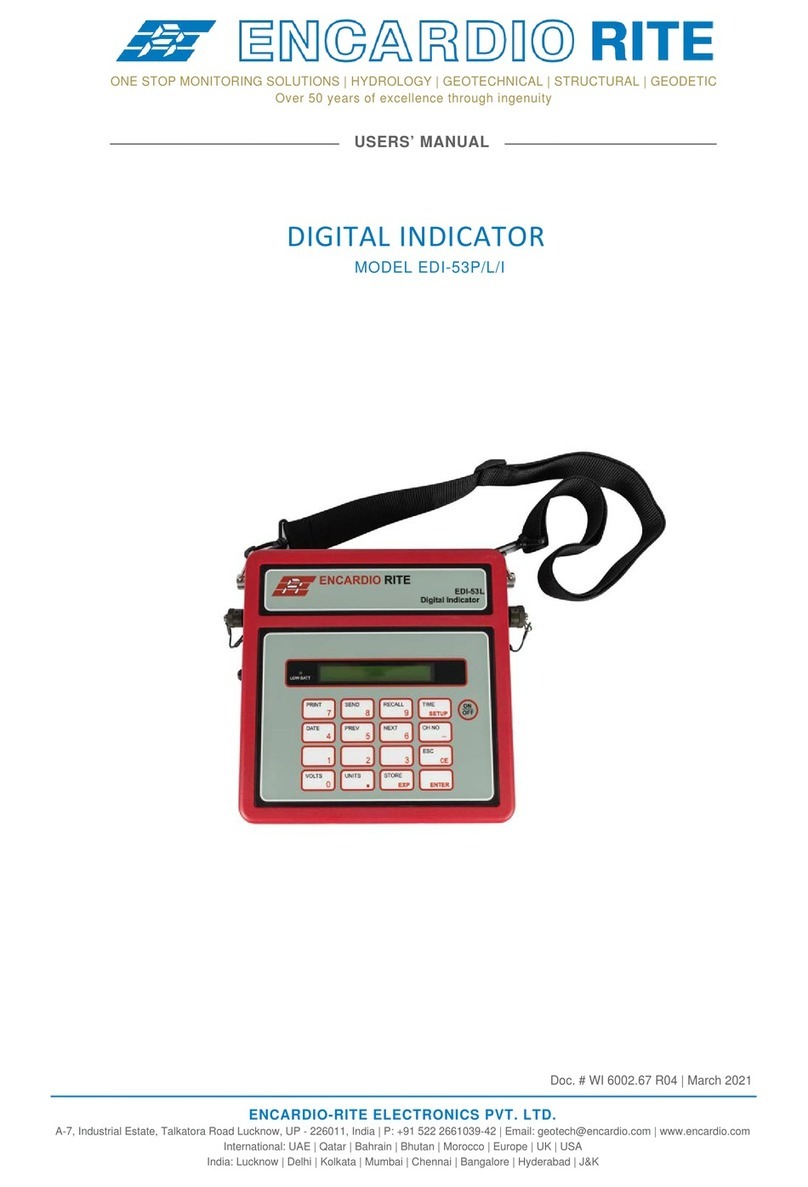
ENCARDIO RITE
ENCARDIO RITE EDI-53P/L/I User manual
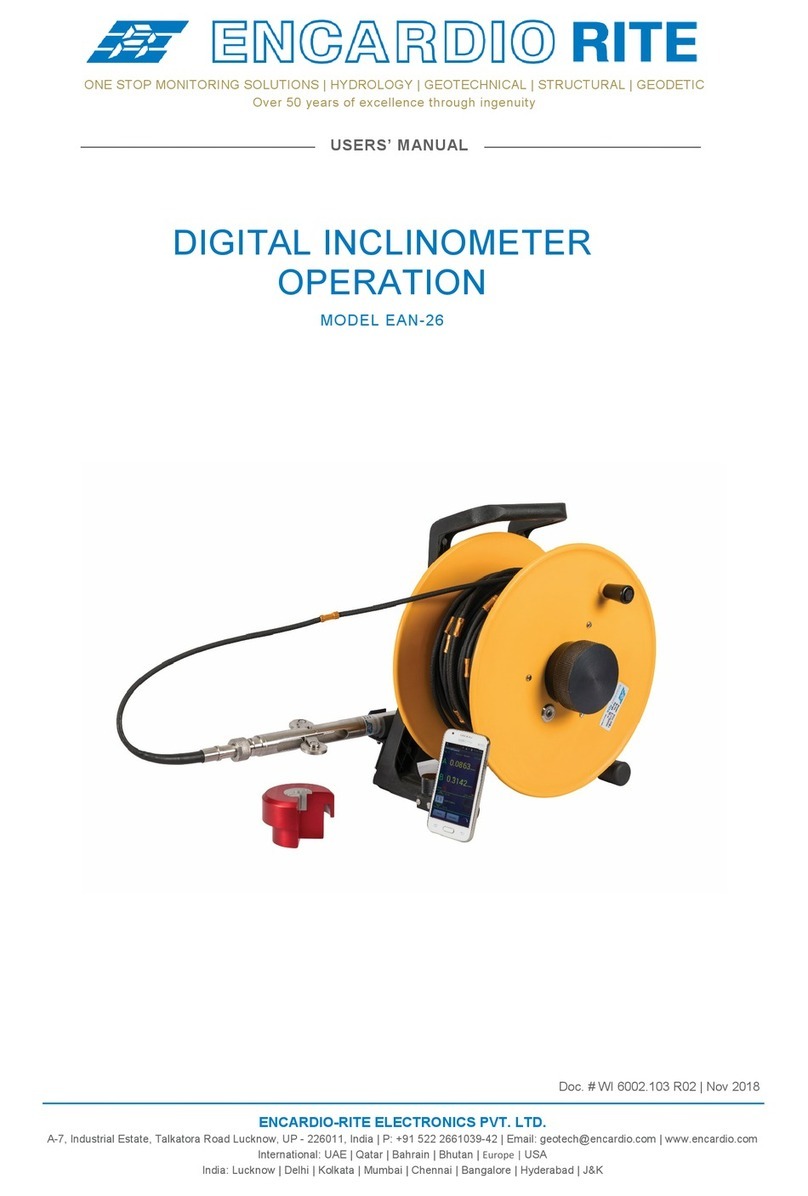
ENCARDIO RITE
ENCARDIO RITE EAN-26 User manual

ENCARDIO RITE
ENCARDIO RITE EAN-90M User manual

ENCARDIO RITE
ENCARDIO RITE EAN-26CCJ User manual

ENCARDIO RITE
ENCARDIO RITE ESM-12S User manual
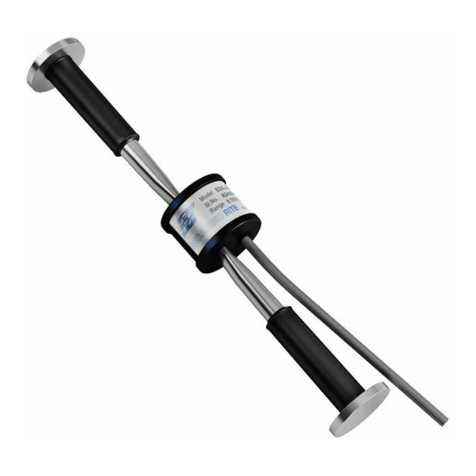
ENCARDIO RITE
ENCARDIO RITE EDS-20V-E User manual
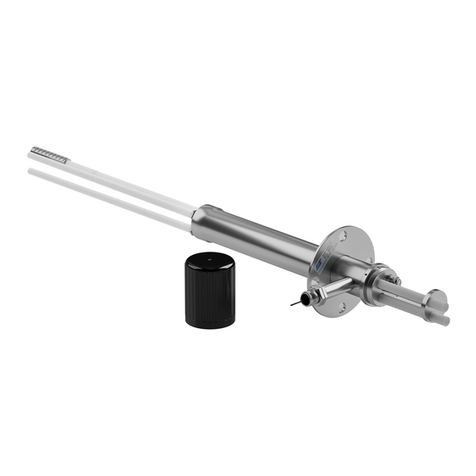
ENCARDIO RITE
ENCARDIO RITE EDS-71V User manual
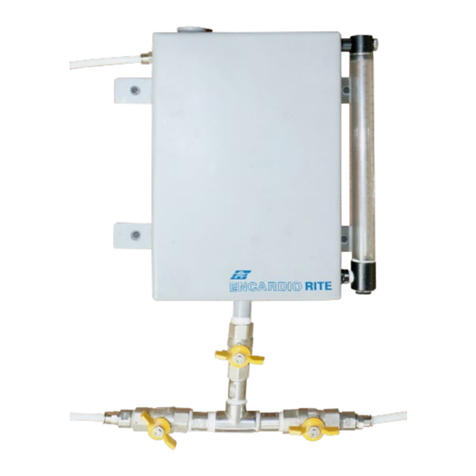
ENCARDIO RITE
ENCARDIO RITE ESM-40S User manual
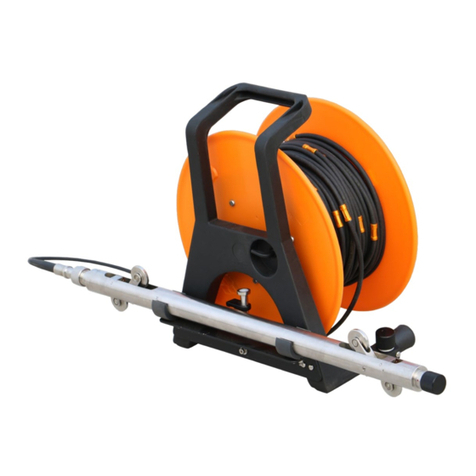
ENCARDIO RITE
ENCARDIO RITE EAN-26MH User manual
